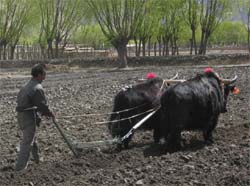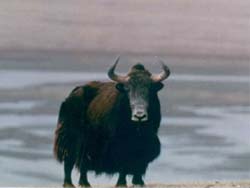

In his monumental work "Origin of Species," Darwin suggested that all domestic animals originated from their wild ancestors through artificial selection and evolution. However, he did not give the details of how human beings domesticate these species. Each of the domestic animal species always includes the highly diversified breeds. It is possible that these morphological varieties originated from the artificial domestication of differentiated wild populations. This suggestion was increasingly confirmed by researches who found the highly divergent genetic lineages are present in the domestic animals. The divergence time of these lineages is obviously earlier than the postglacial colonization of human beings in the world and one likely explanation is that they came from the divergent wild populations. However, this hypothesis has rarely been rigorously tested because of a lack of sufficient wild samples. In addition, the domestication of animals has played a central role in the socioeconomic transitions from hunter-gatherer organization to agricultural settlement and nomadic pastoralism. The elucidation of this domestication provides important information for the human civilization history in the domestication region of an animal.
The yak is the only one of the bovine species that has specifically adapted to the harsh conditions and survived on the Qinghai-Tibetan Plateau (QTP), the largest continuous high elevation ecosystem in the world with an average elevation of more than 4,000 meters above the sea level. This animal is pronounced as "Yak"by the Tibetan and the pronunciation was directly used as its English name. Because of its pig-like crying, it is also called "pig-like cattle." The "Tibetan cattle" is sometimes used by some westerners because this animal is mainly herded inthe Tibetan region. Because its tail looks like that of a horse, the yak is sometimes called "horse-tailed cattle." More than 14 million domesticated yaks (
Poephagus grunniens) are currently herded on the Plateau and the adjacent Asian highlands. They provide the most important resources of living in the arid QTP for human beings, including food, hides, dung fuel and transport power. There are more than 10 breeds in the domestic yak population with highly diversified morphology, i.e., the white breed, which is totally different from the other types with black hair. It has been speculated that their wild ancestors were first domesticated in Tibet because the earliest evidence of human activity and yak husbandry (Qiang Culture), dating from about 10,000 years ago, has been found in this region. However, it is difficult to distinguish between wild and domestic remains. In addition, the domestication of yaks is more difficult than the other animals for two seasons. First, wild yaks are extremely ferocious and highly speedy. Second, the climate and environments of the QTP are extremely hostile, its landscapes are barren and the biotic communities are specifically adapted to the extreme conditions. The costs of living here are severe, for example, the nutritional demands and capture costs are very high while the physiological capacity to benefit from successfully procured resources is low. Did the diversified breeds of yaks originate from the genetically discrete wild populations? When and where were wild yaks domesticated?
Headed by LIU Jianquan, a research team from the Key Lab of Qinghai-Tibetan Plateau Ecological Adaptation, the CAS Northwest Institute of Plateau Biology (NWIPB) analysed mtDNA geneotypes and answered these two interesting questions. Their work was reported online on Setp. 22 by the
BMC Evolutionary Biology.
The researchers still found the presence of deeply maternal divergent phylogenetic groups in domestic yaks as in the other domestic animals,. The divergence time of these two recovered lineages was estimated taking place more than 100,000 years ago, far earlier than the possible colonization of human beings in the QTP. To their surprise, they found that these two deeply divergent maternal lineages occur in a single, small, wild population. This finding suggests that the deep genetic lineages of the domestic yaks are not from the discrete wild populations. Despite the highly diversified morphology, each breed contains the genotypes of the two main lineages and smaller identified clades, suggesting no maternal genetic differentiation between these breeds. Scientists say that all domestic yaks are derived from a single wild gene pool (possibly from the same wild population) and the diversified breeds have no genetic correlation with the population differentiation of the wild yaks. The morphological diversification of breeds resulted from the recent artificial selection since the domestication.
The earliest domestications probably occurred around Qinghai and Tibet around the current wild distribution because these two regions contained high genotype diversity. The scientists further estimated the domestication probably took place between 8000 and 10000 years ago. This estimation is in agreement with the archeological record of yaks with the early activity of human beings on the QTP. It is interesting to see that human beings in the other regions of the world also began to domesticate the local prey animals at this period. Scientists say that it is surprising that our ancestors had started to domesticate the ferocious wild yaks in the arid QTP at the same time.






